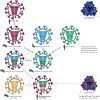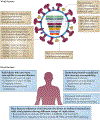Influenza A viruses: new research developments
- PMID: 21747392
- PMCID: PMC10433403
- DOI: 10.1038/nrmicro2613
Influenza A viruses: new research developments
Abstract
Influenza A viruses are zoonotic pathogens that continuously circulate and change in several animal hosts, including birds, pigs, horses and humans. The emergence of novel virus strains that are capable of causing human epidemics or pandemics is a serious possibility. Here, we discuss the value of surveillance and characterization of naturally occurring influenza viruses, and review the impact that new developments in the laboratory have had on our understanding of the host tropism and virulence of viruses. We also revise the lessons that have been learnt from the pandemic viruses of the past 100 years.
Figures




References
-
- Molinari NA et al. The annual impact of seasonal influenza in the US: measuring disease burden and costs. Vaccine 25, 5086–5096 (2007). - PubMed
-
- Johnson NP & Mueller J Updating the accounts: global mortality of the 1918–1920 “Spanish” influenza pandemic. Bull. Hist. Med 76, 105–115 (2002). - PubMed
-
- Palese P & Shaw ML in Fields Virology 5th edn (eds Knipe DM et al.) 1647–1689 (Lippincott Williams & Wilkins, Philadelphia, USA, 2007).
Publication types
MeSH terms
Grants and funding
LinkOut - more resources
Full Text Sources
Other Literature Sources
Medical
Miscellaneous

